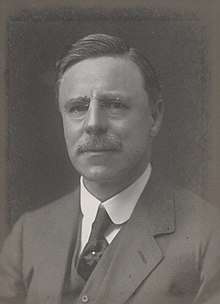1916 Hyde by-election
The Hyde by-election was a Parliamentary by-election. It returned one Member of Parliament to the House of Commons of the United Kingdom, elected by the first past the post voting system. The by-election was held on 30 March 1916.
Vacancy
Francis Neilson had been Liberal MP for the seat of Hyde since the January 1910 general elections. He was a pacifist and had written the anti-war How Diplomats Made War in 1915. He resigned from parliament when his pacifist beliefs conflicted with the First World War.[1]
Electoral history
| Party | Candidate | Votes | % | ± | |
|---|---|---|---|---|---|
| Liberal | Francis Neilson | 5,562 | 51.4 | +11.9 | |
| Conservative | Tom Smith | 5,268 | 48.6 | +9.3 | |
| Majority | 294 | 2.8 | +2.6 | ||
| Turnout | 89.0 | -4.2 | |||
| Liberal hold | Swing | +1.3 | |||
Candidates
The Hyde Liberal Association chose Thomas Owen Jacobsen to defend the seat. Fifty-two-year-old Jacobsen was a locally based businessman who was born in Liverpool, and was the son of a naturalised Dane.[3] He was a master printer and the senior partner in the stationery company of Jacobsen, Welch and Company, whose paper mills were at Hyde, Cheshire.[4][5] In 1914 the Hyde Unionist Association had selected James Leadbitter Knott as their prospective parliamentary candidate in anticipation of a 1914/15 general election. Knott was a son of James Knott a former Conservative MP for Sunderland. When the election was called Knott was on active service. Due to the wartime party truce, the Unionists chose not to oppose the Liberal candidate and Jacobsen was endorsed by the Asquith led Coalition Government. DP Davies came forward as an Independent candidate. Davies was the nominee of the National Union of Attested Married Men, an organisation opposed to the government's policy on conscription.[6]
Result
Jacobsen held the seat for the government;

| Party | Candidate | Votes | % | ± | |
|---|---|---|---|---|---|
| Liberal | Owen Jacobsen | 4,089 | 56.0 | +4.5 | |
| Independent | DP Davies | 3,215 | 44.0 | n/a | |
| Majority | 874 | 12.0 | |||
| Turnout | 54.7 | ||||
| Liberal hold | Swing | ||||
Aftermath
In 1916 the prospective Unionist candidate, Leadbitter Knott was killed in action. Following boundary changes the Hyde constituency was abolished and merged with Unionist held Stalybridge. The Lloyd George led Coalition Government chose not to endorse Jacobsen but his Unionist opponent, the sitting MP for Stalybridge. This helped ensure Jacobsen's defeat;
| Party | Candidate | Votes | % | ± | |
|---|---|---|---|---|---|
| Unionist | John Wood | 13,462 | 51.4 | n/a | |
| Labour | Walter Fowden | 6,508 | 24.8 | n/a | |
| Liberal | Owen Jacobsen | 6,241 | 23.8 | n/a | |
| Majority | 6,954 | 26.6 | n/a | ||
| Turnout | 60.0 | n/a | |||
| Unionist win | |||||
References
- "Resignation of Mr Neilson", The Times, 3 March 1916, p.9
- British parliamentary election results, 1885-1918 (Craig)
- "Resignation of Mr Neilson", The Times, 3 March 1916, p.9
- "S. E. Southwark Contest", The Times, 21 November 1921, p.7
- "News in Brief", The Times, 13 March 1916, p.5
- British parliamentary election results, 1885-1918 (Craig)
- British parliamentary election results, 1885-1918 (Craig)